#Acipenseriformes
Text
Do you ever just think about sturddlefish? I do

#Sturddlefish#Sturgeon#Paddlefish#Fish#Today I bring you this. Tomorrow? Who knows#How tf do you tag stuff so people will actually see it#Chordata#Actinopterygii#Acipenseriformes#Acipenseridae#Polyodontidae#Silly#Not a reblog#Aquatic
1K notes
·
View notes
Text
Taxonomy Tournament: Fish
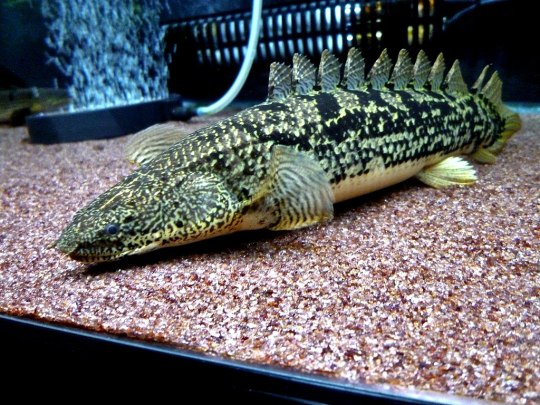

Polypteridae. This order is made up of reedfish and bichirs, freshwater fish that have lungs, with some species capable of breathing air.
Acipenseriformes. This order is made up of basal fishes with skeletons made mostly of cartilage. It includes sturgeons and paddlefish.
#animals#biology#polls#poll tournament#zoology#reedfish#bichirs#fish#sturgeons#Polypteridae#Acipenseriformes#0x4v0x3b
420 notes
·
View notes
Note
Do you have any cool facts about Missouri wildlife?
I'd love to share something with my Midwestern friends, and thank you for always updating this blog!
I don't know if i have any Missouri animal facts per se... but I can share some of the state symbols with everyone.
We moved around a lot when we first came to the U.S. and we lived briefly in Kansas City. I have great memories of going to the Ozarks at Christmas time (near Lake of the Ozarks). I specifically remember following woodpeckers and deer around the forest in the snow.
SOME MISSOURI STATE SYMBOLS:
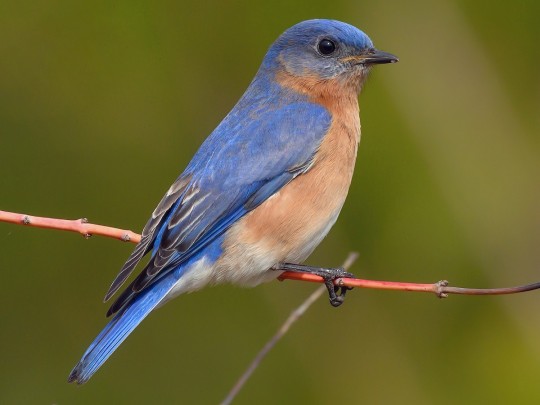
STATE BIRD: Eastern Bluebird (Sialia sialis), family Turdidae, order Passeriformes, found across much of the central and Eastern U.S., SE Canada, and NW Mexico
Changes in land use lead to drastic declines in Eastern Bluebirds after the early 1900s. They have recovered in many places, due to "bluebird trails", reestablishing appropriate habitat and nest box campaigns for public and private property.
Find out more: NestWatch | Eastern Bluebird - NestWatch
Blue birds are in the thrush family, Turdidae, along with American Robins.
They eat mainly worms, insects, and other small invertebrates (but also take berries for part of the year).
Bluebirds are cavity nesters, nesting in tree holes usually, but will readily take to properly constructed and placed nest boxes.
Males (pictured) are brighter blue, and females are a more muted and faded blue or bluish gray.
photograph by Keith Kennedy

STATE AQUATIC ANIMAL: American Paddlefish (Polyodon spathula), family Polyodontidae, order Acipenseriformes, found in various parts of the Mississippi River basin
This species is the only member of this family that still exists. They are most closely related to sturgeons. This order, Acipenseriformes, is considered one of the most evolutionarily primitive groups of ray finned fishes.
They do not have scales, and their skeleton is mostly cartilaginous.
They are filter feeders. Their heads and rostrums are covered with thousands of sensory receptors, which help them locate zooplankton swarms.
They are considered "vulnerable" due to overfishing, habitat degradation and destruction, and pollution.
photograph via: US Fish & Wildlife Service
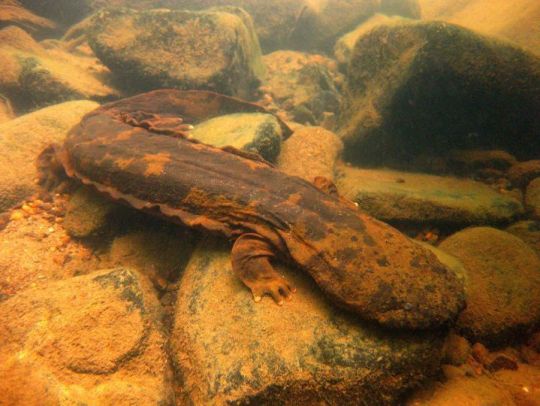
STATE ENDANGERED ANIMAL: Eastern Hellbender (Cryptobranchus alleganiensis), family Cryptobranchidae, eastern United States
The largest salamander in the Americas, it grows to a total maximum length of up to 40 cm (15.7 in).
Though nationally it is considered to be just "vulnerable", in some states (like Missouri), it is "endangered".
photograph by Mark Tegges

STATE REPTILE: Three-toed Box Turtle (Terrapene triunguis), family Emydidae, found in the South-central and Southeastern U.S.
This specie shas been considered to be a subspecies of the Eastern Box Turtle, T. carolina (and still is by some herpetologists).
These turtles are terrestrial, but are not closely related to tortoises. They are in the same family as aquatic sliders, pond turtles, cooters, map turtles, and painted turtles.
photograph by Noppadol Paothong
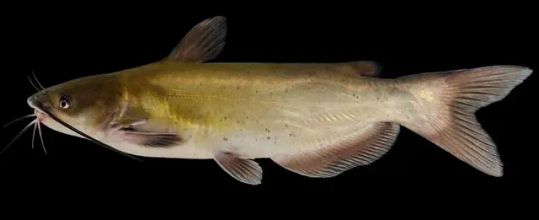
STATE FISH: Channel Catfish (Ictalurus punctatus), family Ictaluridae, order Siluriformes, found in freshwater habitats in the eastern and southern US, southern Canada, and northern Mexico
They are widely caught, and have been introduced into waterways in other parts of North America and around the world. (In some places they are considered an invasive species).
photograph via: Missouri Dept. of Conservation

photograph by Brian.gratwicke
#Acipenseriformes#paddlefish#fish#ichthyology#box turtle turtle reptile#herpetology#bluebird#thrush#bird#ornithology#north america#hellbender#salamander#amphibian#animals#nature#catfish
177 notes
·
View notes
Text
Uncharismatic Fact of the Day
The sturgeon's name is quite appropriate; it loosely translates to 'stirrer'. These species have poor eyesight, and instead find food by feeling through the mud with their sensitive snouts and whisker-like barbels.

(Image: A group of Atlantic sturgeon (Acipenser oxyrhynchus) by Ryan Hagerty)
If you like what I do, consider leaving a tip or buying me a ko-fi!
313 notes
·
View notes
Text

Atlantic sturgeon
By: Hans Reinhard
From: The Complete Encyclopedia of the Animal World
1980
#atlantic sturgeon#sturgeon#acipenseriform#bony fish#fish#1980#1980s#Hans Reinhard#The Complete Encyclopedia of the Animal World (1980)
426 notes
·
View notes
Text
Easily my most popular post was about paddlefish, so this Wet Beast Wednesday it's time to give them their moment in the sun. Paddlefish are members of the family Polyodontidae and one of only two surviving members of the order Acipenseriformes, the other being sturgeons. The Acipenseriformes are one of the oldest lineages of ray-finned fish and diverged from the ancestors of all other modern ray-finned fish around 300 millions years ago. While paddlefish have been around since the Cretaceous period, there is only one living species, the American paddlefish (Polyodon spathula). Another modern species is the Chinese paddlefish (Psephurus gladius), but the last sighting of one was in 2003 and they were officially declared extinct in 2022. In this post, unless I specify otherwise everything I say will be referring to the American paddlefish.

(image: either an American paddlefish or a basking shark that got its nose caught in a hydraulic press)
Paddlefish are named for their very long rostrums which are packed full of electrorecepting organs called the ampullae of Lorenzini used to sense electric fiends in the water. The ampullae are not only on the rostrum, but also on the head and large skin flaps that extend from the operculum (gill cover). They are so sensitive that paddlefish are able to sense the movement of individual body parts of zooplankton. Paddlefish use their rostrums to detect their prey, which consists almost entirely of zooplankton. They are ream suspension feeders, swimming toward swarms of zooplankton with their mouths open. As the water passes through the gills, gill rakers filter out the zooplankton, which is then swallowed. Other fish that use this feeding method include basking sharks. While the rostrum is the primary method of prey detection, other ampullae on the head and operculum flap allow the fish to still effectively find food even if the rostrum is damaged or destroyed. When working fish fish on the Mississippi I caught multiple paddlefish who lost their rostrums to propeller strikes and were still doing fine. Electroreception is their main sense, with their eyesight being extremely poor.

(image: the skeletal structure of the rostrum)
As chordates, paddlefish have a notochord that runs from the head down the body. In most modern chordates, the notochord is only present in the embryo and is lost during development. This is not the case for paddlefish, who retain their notochord into adulthood, where is acts as a soft spine. While paddlefish (and their sturgeon cousins) are bony fish, they have lost most of the bone and now have skeletons composed almost entirely of cartilage. It is for this reason that early taxonomists initially miscategorized paddlefish as freshwater sharks. To be fair, they do look a lot like miniature basking sharks. Who crossbred with spoons. They also lost their scales and have smooth, easily damaged skin instead. Their skin is so easily damaged that just being caught in nets can leave scars. Paddlefish are large and long-lived. The American species reaches an average of 1.5 m (5 ft) in length, with the rostrum making up a third of that, and a weight of 27 kg (60 lbs). The largest recorded specimen was 2.16 m (7 ft 1 in) and an estimated 90 kg (198 lbs). Despite being one of the largest American freshwater fish, they paled in comparison to the Chinese species, which could reach 3 m (9.8 ft) and 500 kg (1,100 lbs). The largest Chinese paddlefish on record was 7 m (23 ft) long and was estimated to weigh "a few thousand pounds". The Chinese paddlefish also preferred larger prey, feeding largely on small fish and crustaceans. American paddlefish live an average of 5 to 8 years, but in the right circumstances can live up to 60 years, with females generally living longer. The Chinese paddlefish had an estimated average lifespan of 29-38 years. In both species, it is believed that human activity drastically reduced their average lifespans.
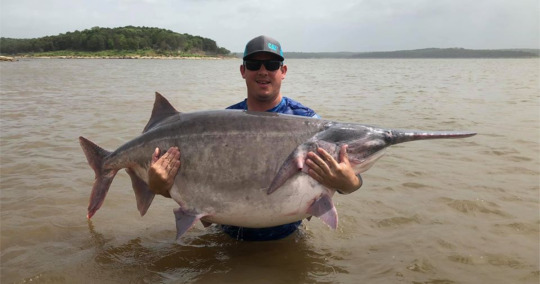
(image: an absolute unit of an American paddlefish)
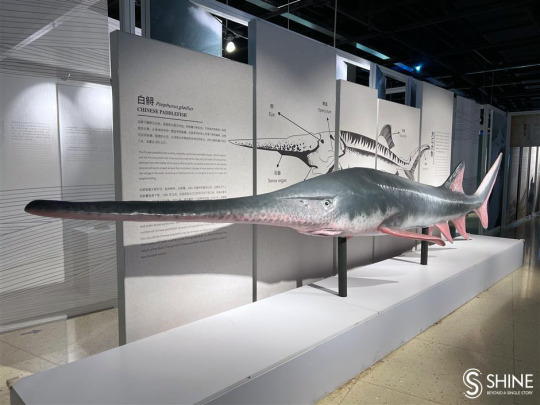
(image: a reconstruction of a Chinese paddlefish from the Shanghai Science and Technology Museum)
Paddlefish travel upriver to spawn in spring. They prefer to span on shallow gravel bars that would be exposed to air if not for spring rainfall and snow melt. Because they require very specific conditions to spawn, spawning rarely occurs every year. Every 4-5 years is more common. Paddlefish are broadcast spawners, with both males and females releasing gametes into the water column. Fertilized eggs are negatively buoyant and sticky. They will sink to the bottom and stick to the gravel. Once hatched, larvae will be swept down river to develop in deep pools. They are born without rostrums, which start to grow almost immediately. Paddlefish mature late, with females becoming sexually mature between 7 and 10 years of age, with a few not maturing until as late as 16-18 years. Human activity is resulting in many individuals dying before becoming sexually mature. American paddlefish are cross-fertile with the Russian sturgeon (Acipenser gueldenstaedtii), producing a hybrid offspring known as the sturddlefish despite being separated by the Atlantic ocean and 184 million years of evolution. This was discovered by accident when scientists introduced paddlefish sperm too sturgeon eggs as a control group for an experiment. I made a post on the sturddlefish which you can read here.

(image: three larval paddlefish of different ages)
American paddlefish are classified as vulnerable by the IUCN. They are native to the Mississippi river basin that encompasses much of the midwest and south of the United States, but their range used to be larger, reaching into Lake Huron, the Northeastern U.S. and parts of Canada. This reduction of native range is due largely to human activity, mostly overfishing and habitat loss. Zebra mussels, an invasive species, are a major competition for paddlefish as theybith feed on zooplankton. Reintroduction programs have begun in some of the states they were extirpated from, and they have been introduced to China, Cuba, and multiple countries in Europe for use in fishing and caviar production. 13 states allow for sport fishing of paddlefish, some of them relying on restocking to maintain a population for anglers. Paddlefish meat is edible and their eggs can be used for caviar. Paddlefish can be raised in captivity, but must will not spawn in captivity and so establishing captive populations requires gonad extraction and artificial insemination. Poaching of wild paddlefish for their eggs is an ongoing problem. The extinction of the Chinese paddlefish is believed to be the result of overexploitation and habitat loss.
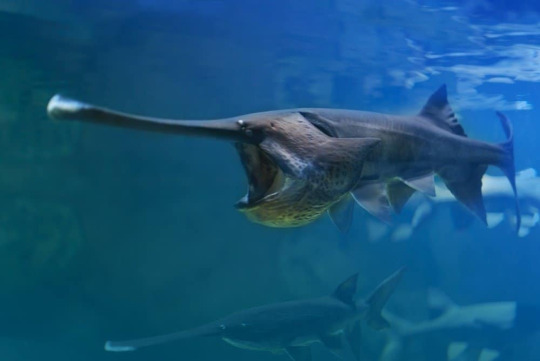
(image: a paddlefish with its mouth open)
#wet beast wednesday#biology#zoology#fish#ecology#fishblr#freshwater biology#freshwater fish#aquatic biology#paddlefish#american paddlefish#chinese paddlefish#animal facts
518 notes
·
View notes
Note
May I receive a sturgeon in these trying times? Any sturgeon!
African Sturgeon
If you know anything about Acipenseriformes you might be thinking, “but sturgeonposting, there ARE no sturgeons in Africa!” And you would be right — if you only counted live sturgeon. In November of 2022, however, David Martill discovered a fossilized sturgeon scute at a well known dig site in Morocco. Martill, a professor of paleobiology at the University of Portsmouth, recognized the fossil as that of a sturgeon immediately. The fossil is currently believed to be from the Upper Cretaceous period. This is a groundbreaking discovery on the front of sturgeon evolution as it suggests that they once swam in the waters around supercontinent Gondwana, of which Africa was a part — waters that were, until last year, considered too warm to support a sturgeon population.
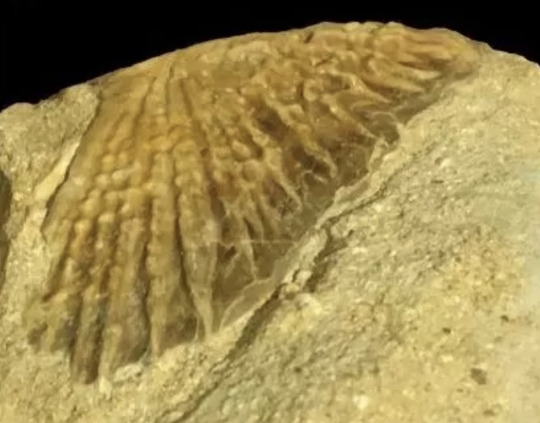
Here’s the paper if anyone wants it
#any sturgeon you say…..#sturgeon fish#sturgeon#fish#ask#African sturgeon#ichthyology#paleontology#paleobiology#Acipenseridae#fossil#sturgeon facts
221 notes
·
View notes
Text
cannot decide my new fursona for the life of me
so i'm putting it to a poll! putting all my inspo into this poll, and whatever % the 'gene' ends up being will be how much it is expressed. i'm trusting you guys
3 notes
·
View notes
Text

So, tldr for the folks who don’t know: what edda is asking about here is the issue of the Tanis site in North Dakota. The geology of the site may record the actual minutes to hours of events that occurred right after the asteroid impact that ended the Cretaceous Period (the KPg or KT extinction). In the last few days, accusations of falsified data related to the Tanis site have been leveled at a major figure involved with its description and excavation. That’s the Drama and it is…not good. We’ll hit that at the end.
Since I started yelling about it to edda and everyone else who’d sit still long enough to hear me thank you all for your patience I love you all, I’ve been reading as many papers as I can get my hands on related to the Tanis site and the extinction event in general. I’ve cited the most accessible-to-average-readers and key papers under the cut below. The story is...incredible.
The asteroid that caused the KPg extinction struck the earth off the Yucatán Peninsula, at the Chicxulub impact crater. Ten kilometers in diameter, leaving behind a crater a hundred and eighty kilometers across which is still intact today, the asteroid set off an instant apocalypse. Megatsunamis, firestorms, and earthquakes, and debris falling from the sky were followed by clouds of dust that dropped temperatures around the world. Oceans acidified and plants couldn’t photosynthesize. Evidence of this impact is found all over the world, from seafloors that fossilized with the ripples of tsunamis still intact to layers of charcoal and soot left behind by wildfires. (For a comprehensive review of all this, including a response to counterevidence, see the Kring 2007 paper specifically, that citation links directly to a PDF with no paywall.)
Most importantly, though, the impact left behind a clear, visible boundary line: a layer of iridium-rich clay found worldwide. That’s an element rare on earth, but not nearly as rare in extraterrestrial bodies. Above that layer, there are no non-avian dinosaurs. It marks the KPg extinction boundary. Wherever you find it, you know exactly what you’re dealing with.
At the Tanis site, this iridium layer is directly above a dramatic bone bed and a cluster of geological features that also align with other signs of the Chicxulub impact. The site is described in “A seismically induced onshore surge deposit at the KPg boundary, North Dakota” by DePalma et al. 2019; the citation I’ve included takes you directly to the article, open access. If you don’t feel like reading the entire article, here’s the most relevant piece from the abstract:
“Associated ejecta and a cap of iridium-rich impactite reveal that its emplacement coincided with the Chicxulub event. Acipenseriform fish, densely packed in the deposit, contain ejecta spherules in their gills and were buried by an inland-directed surge that inundated a deeply incised river channel before accretion of the fine-grained impactite. Although this deposit displays all of the physical characteristics of a tsunami runup, the timing (<1 hour postimpact) is instead consistent with the arrival of strong seismic waves from the magnitude Mw ∼10 to 11 earthquake generated by the Chicxulub impact, identifying a seismically coupled seiche inundation as the likely cause.” (DePalma et al., 2019)
In simpler terms: the site is located directly under the iridium layer and full of debris thrown up from an impact. Sturgeons and other fish, which are packed in a deep river channel, have tiny spheres of ejected glass in their gills and were buried by a surge of mud and water coming upstream in the river. The timing of it (determined by methods that are beyond my limited understanding as a highly enthusiastic amateur) indicates that the surge was triggered by massive earthquakes caused by the Chicxulub impact.
So we are almost completely certain at this point that this site is a record of the hours and minutes immediately following the asteroid impact. The current mess surrounds two papers released last year and this year, both of which have claimed to determine the exact season in which the asteroid hit. Please note that, although I’ve cited both papers for the sake of comprehensiveness, I would at this moment believe Melissa During’s claim that the discovery is hers and her paper from 2022 should be considered valid, not the DePalma paper from last year (which has been accused of falsified data to “scoop” the story before During could publish). The DOI links for both papers will take you to open access versions of the papers where you can read them in their entirety.
It was spring in the northern hemisphere on the day of the impact.
The bones of the sturgeons and other fish, when closely studied, reveal growth patterns consistent in all other relatives with seasonal dietary fluctuations. The growth records in the fossilized bones indicate that they were still in the middle of the springtime feeding season. The speed of their death froze the growth of their bones in time, preserving that moment to be seen millions of years later. No matter how this conflict surrounding the papers shakes out...it was spring.
Did you know that flowering plants evolved during the Cretaceous period? In North America, there were flowers of the same order that includes heather, phlox, and primroses. There were magnolias and buttercups. Even the ancestors of roses.
There were flowers blooming in the moment that the asteroid struck.
Alvarez, Luis W., Walter Alvarez, Frank Asaro, and Helen V. Michel. "Extraterrestrial cause for the Cretaceous-Tertiary extinction." Science 208, no. 4448 (1980): 1095-1108. http://www.jstor.org/stable/1683699
DePalma, Robert A., Anton A. Oleinik, Loren P. Gurche, David A. Burnham, Jeremy J. Klingler, Curtis J. McKinney, Frederick P. Cichocki et al. "Seasonal calibration of the end-cretaceous Chicxulub impact event." Scientific reports 11, no. 1 (2021): 1-9. https://doi.org/10.1038/s41598-021-03232-9
DePalma, Robert A., Jan Smit, David A. Burnham, Klaudia Kuiper, Phillip L. Manning, Anton Oleinik, Peter Larson et al. "A seismically induced onshore surge deposit at the KPg boundary, North Dakota." Proceedings of the National Academy of Sciences 116, no. 17 (2019): 8190-8199. https://doi.org/10.1073%2Fpnas.1817407116
During, Melanie AD, Jan Smit, Dennis FAE Voeten, Camille Berruyer, Paul Tafforeau, Sophie Sanchez, Koen HW Stein, Suzan JA Verdegaal-Warmerdam, and Jeroen HJL van der Lubbe. "The Mesozoic terminated in boreal spring." Nature 603, no. 7899 (2022): 91-94. https://doi.org/10.1038/s41586-022-04446-1
Friis, Else Marie, K. Raunsgaard Pedersen, and Peter R. Crane. "Cretaceous angiosperm flowers: innovation and evolution in plant reproduction." Palaeogeography, palaeoclimatology, palaeoecology 232, no. 2-4 (2006): 251-293. https://doi.org/10.1016/j.palaeo.2005.07.006
Henehan, Michael J., Andy Ridgwell, Ellen Thomas, Shuang Zhang, Laia Alegret, Daniela N. Schmidt, James WB Rae et al. "Rapid ocean acidification and protracted Earth system recovery followed the end-Cretaceous Chicxulub impact." Proceedings of the National Academy of Sciences 116, no. 45 (2019): 22500-22504. https://doi.org/10.1073/pnas.1905989116
Hildebrand, Alan R., Glen T. Penfield, David A. Kring, Mark Pilkington, Antonio Camargo Z, Stein B. Jacobsen, and William V. Boynton. "Chicxulub crater: a possible Cretaceous/Tertiary boundary impact crater on the Yucatan Peninsula, Mexico." Geology 19, no. 9 (1991): 867-871. https://doi.org/10.1130/0091-7613(1991)019%3C0867:CCAPCT%3E2.3.CO;2
Kring, David A. “The Chicxulub impact event and its environmental consequences at the Cretaceous–Tertiary boundary.” Palaeogeography, Palaeoclimatology, Palaeoecology 255, no. 1-2 (2007): 4-21. http://www.ela-iet.com/EMD/Kring2007ChicxulubK-TReview.pdf
Nixon, Kevin C., and William L. Crepet. "Late Cretaceous fossil flowers of ericalean affinity." American Journal of Botany 80, no. 6 (1993): 616-623. https://doi.org/10.1002/j.1537-2197.1993.tb15230.x
Pope, Kevin O., Kevin H. Baines, Adriana C. Ocampo, and Boris A. Ivanov. "Energy, volatile production, and climatic effects of the Chicxulub Cretaceous/Tertiary impact." Journal of Geophysical Research: Planets 102, no. E9 (1997): 21645-21664. https://doi.org/10.1029/97JE01743
Schulte, Peter, J. A. N. Smit, Alexander Deutsch, Tobias Salge, Andrea Friese, and Kilian Beichel. "Tsunami backwash deposits with Chicxulub impact ejecta and dinosaur remains from the Cretaceous–Palaeogene boundary in the La Popa Basin, Mexico." Sedimentology 59, no. 3 (2012): 737-765. https://doi.org/10.1111/j.1365-3091.2011.01274.x
Schulte, Peter, Laia Alegret, Ignacio Arenillas, José A. Arz, Penny J. Barton, Paul R. Bown, Timothy J. Bralower et al. "The Chicxulub asteroid impact and mass extinction at the Cretaceous-Paleogene boundary." Science 327, no. 5970 (2010): 1214-1218. https://doi.org/10.1126/science.1177265
Vajda, Vivi, J. Ian Raine, Christopher J. Hollis, and C. Percy Strong. "Global effects of the Chicxulub impact on terrestrial vegetation—review of the palynological record from New Zealand Cretaceous/Tertiary boundary." Cratering in marine environments and on ice (2004): 57-74. DOI: 10.1007/978-3-662-06423-8_4
23 notes
·
View notes
Text
The beluga (/bəˈluːɡə/), also known as the beluga sturgeon or great sturgeon (Huso huso), is a species of anadromous fish in the sturgeon family (Acipenseridae) of order Acipenseriformes. It is found primarily in the Caspian and Black Sea basins, and formerly in the Adriatic Sea. Based on maximum size, it is the third-most-massive living species of bony fish.[6] Heavily fished for the female's valuable roe, known as beluga caviar, wild populations have been greatly reduced by overfishing and poaching, leading IUCN to classify the species as critically endangered.
Beluga
Temporal range: Pleistocene-recent[1]

Huso huso
5 notes
·
View notes
Note
Favorite fish?
This is far too vague of an ask. There are so many fish and it is impossible to choose one as my favorite, not to mention that “fish” is not a real category of animal, and in fact all land tetrapods can also be considered fish. You will have to be more specific, for instance, what is my favorite of the lamniformes, or my favorite acipenseriformes.
However, lumpfish are definitely the most beautiful and most powerful.
18 notes
·
View notes
Text
Fossile di storione di 66 milioni di anni trovato in Marocco
Lo storione marino europeo (Acipenser sturio).
Il nuovo esemplare rappresenta la prima presenza di un pesce acipenseriforme (storione) nel continente africano.
Storione è il nome comune per quasi 30 specie di pesci appartenenti alla famiglia Acipenseridae.
Questi pesci sono stati a lungo apprezzati per la loro carne e vengono mangiati come caviale.
Ma a causa della pesca eccessiva, insieme…

View On WordPress
0 notes
Text
Taxonomy Tournament: Fish


Acipenseriformes. This order is made up of basal fishes with skeletons made mostly of cartilage. It includes sturgeons and paddlefish.
Anguilliformes. This order is made up of eels, elongated fish that lack pectoral fins, and swim by generating waves with their bodies, allowing them to swim backwards. Note that electric eels are part of a different order.
#animals#biology#polls#poll tournament#zoology#sturgeons#fish#eels#Acipenseriformes#Anguilliformes#0x3bv0xc4#animal tournament#Animal Tournament Round 1
102 notes
·
View notes
Photo

The long goodbye: Study declares ancient Chinese paddlefish extinct
In 2003, researchers from the Chinese Academy of Fishery Sciences captured, tagged and released a female Chinese paddlefish (Psephurus gladius) that had accidentally been caught in the Yangtze River. In just 12 hours, all communication with the fish tag was lost. That was the last time scientists saw a living Chinese paddlefish.
The same team of researchers, led by Qiwei Wei, assessed the species as critically endangered (possibly extinct) for the IUCN Red List in 2009. But the Chinese paddlefish, listed among the world’s largest freshwater fish species with lengths reaching up to 7 meters (23 feet), likely went extinct before that assessment, a new study concludes. In fact, by 1993, the species was most probably functionally extinct; that is, it was unable to reproduce successfully and its population was too small to be significant in any manner, researchers have now determined.
The Chinese paddlefish is, or rather was, a unique species. It was one of only two living species of paddlefish, the other being the American paddlefish (Polyodon spathula), part of an ancient group of fish known to have existed since the Lower Jurassic, 200 million years ago. It was also the only species in the genus Psephurus.
“Given that the Chinese paddlefish was one of the two extant species of paddlefishes, loss of such unique and charismatic megafauna representative of freshwater ecosystems is a reprehensible and an irreparable loss,” Wei, a professor at the Chinese Academy of Fishery Sciences and co-author of the study, told Mongabay.
The Chinese paddlefish wasn’t always rare. Historically it occurred across many large rivers that flow into the West Pacific, but since the 1950s it was seen mostly in the Yangtze River, researchers say. There, too, its numbers declined dramatically due to overfishing — estimates put harvests at around 25 tonnes of paddlefish per year during the 1970s — and fragmentation of its riverine habitat. A major death knell came with the construction of the first dam on the Yangtze River, the Gezhouba Dam, which blocked the routes of most migratory fish in the river, including the Chinese paddlefish. The dam split the fish’s population into two isolated groups, and prevented adult fish from moving upstream to spawn and young fish from swimming to downstream feeding areas.
#Chinese Paddlefish#Psephurus gladius#Psephurus#Polyodontidae#Acipenseriformes#Actinopterygii#Osteichthyes#fish#extinction#conservation#dams#biodiversity#China
51 notes
·
View notes
Text
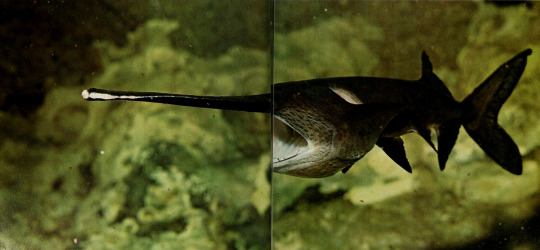
Paddlefish
By: Russe Kinne
From: Natural History Magazine
1977
128 notes
·
View notes
Photo

American Paddlefish (Polyodon spathula)
American paddlefish are a primitive fish that have inhabited North America since the Cretaceous period 65 million years ago. The American Paddlefish inhabits large, slow‐flowing, freshwater rivers such as the Mississippi River and its tributaries. Paddlefish are a long‐lived species...
Read more: USFWS - Fish and Aquatic Conservation
The American Paddlefish is one of only two paddlefish species in the world and is the only paddlefish species in North America, the other is in China. This fish is targeted for its high quality caviar thus making it prone to over harvest and illegal harvest. It is managed differently among states in its range. In some states the paddlefish is a commercial species, in some a sport fish species and in others a state threatened/endangered species...
read more: USFWS - Midwest Fisheries Program
The American paddlefish (Polyodon spathula) is a species of basal ray-finned fish closely related to sturgeons in the order Acipenseriformes. Fossil records of paddlefish date back over 300 million years, nearly 50 million years before dinosaurs first appeared.
American paddlefish are smooth-skinned freshwater fish commonly called paddlefish, but are also referred to as Mississippi paddlefish, spoon-billed cats, or spoonbills.
American paddlefish are often referred to as primitive fish, or relict species because they retain some morphological characteristics of their early ancestors, including a skeleton that is almost entirely cartilaginous, and a paddle-shaped rostrum (snout) that extends nearly one-third their body length...
Read more: https://en.wikipedia.org/wiki/American_paddlefish
#paddlefish#fish#fisheries#conservation#aquatic#freshwater#rivers#nature#animals#north america#ichthyology
66 notes
·
View notes